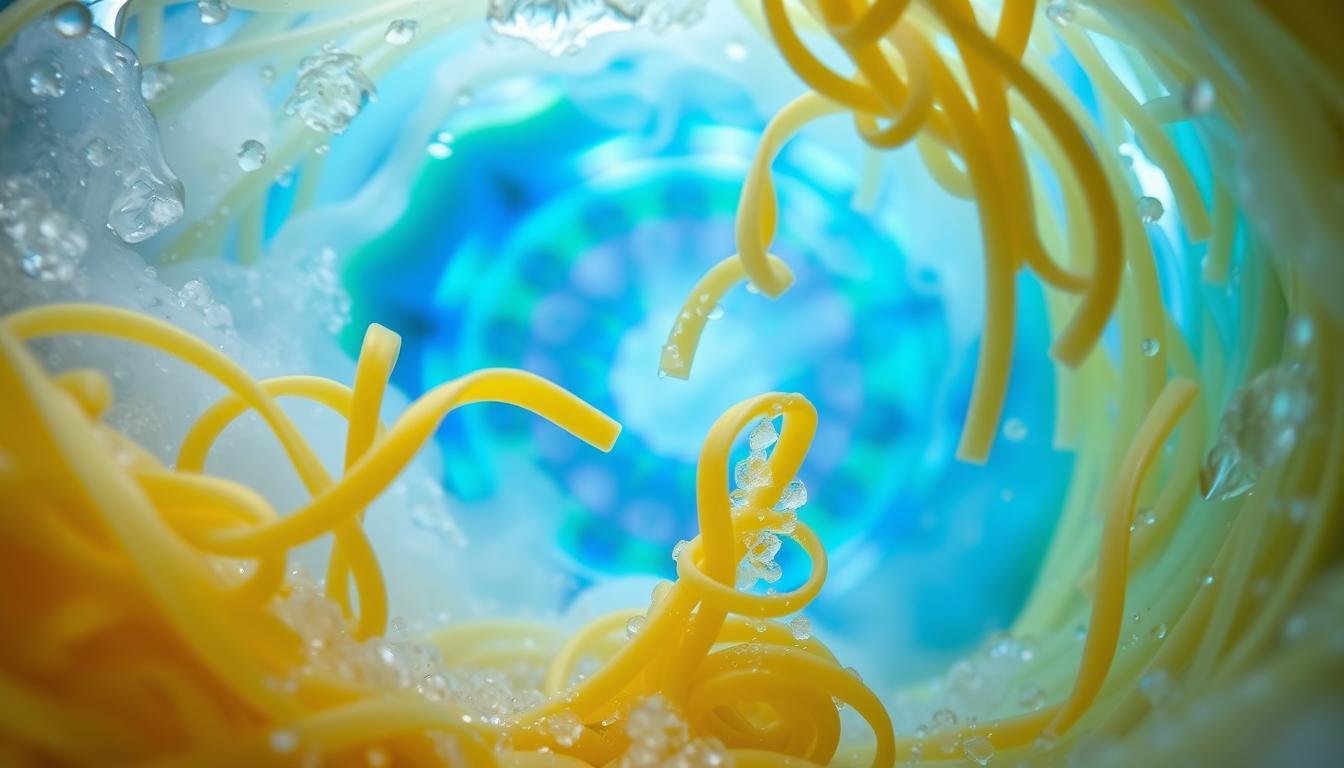Did you know 95% of home cooks pour away a nutrient-rich liquid that could transform their meals? That cloudy broth left after preparing your favorite Italian staple isn’t waste – it’s packed with natural compounds essential for perfect sauces.
As flour-based noodles heat in bubbling water, their structure changes. Tiny starch molecules escape into the liquid, creating visible swirls and foam. This process starts within seconds and continues until you drain your meal.
Chefs treasure this starchy water as a flavor enhancer. It helps sauces cling to surfaces while adding body without heavy creams. The white residue in your pot? That’s concentrated starch – proof you’ve unlocked the ingredient’s full potential.
Key Takeaways
- Starch release begins instantly when noodles meet hot liquid
- Cloudy cooking water indicates valuable thickening agents
- Residual film in pots demonstrates starch concentration
- Professional kitchens reuse this liquid for superior sauces
- Understanding this process elevates home cooking results
Understanding the Science Behind Pasta and Starch
What transforms simple wheat into that perfect al dente bite? The answer lies in its starch composition. Wheat flour – the main ingredient in most noodles – contains tightly packed starch granules. These remain inactive until exposed to heat and moisture during preparation.

The Role of Wheat Flour and Starch in Pasta
Starch molecules act like microscopic sponges. When submerged in hot water, they absorb liquid and expand up to 30 times their original size. This swelling creates pressure that eventually ruptures the pasta’s outer layers.
Three key stages occur:
- Initial hydration at 140°F (60°C)
- Rapid expansion at 180°F (82°C)
- Granule rupture releasing starch particles
How Boiling Water Triggers Starch Release
The bubbling action of boiling water accelerates this process. Vigorous movement pushes freed starch molecules upward, forming that familiar foamy layer. You’ll notice maximum cloudiness in the first 2-3 minutes as surface layers break down fastest.
Contrary to popular belief, this isn’t overcooking. That milky liquid contains amylose and amylopectin – natural thickeners chefs use to create glossy, restaurant-quality sauces. By understanding these reactions, you gain control over texture and sauce adhesion.
Optimizing Your Pasta Cooking Techniques
Transforming your home-cooked meals begins with one simple change in your pot. Traditional methods often dilute flavor potential through excessive water use – but smarter techniques unlock better results.

Cooking with Less Water for Concentrated Starch
Cutting water volume boosts starch concentration dramatically. Use 1.5-2 quarts per pound instead of 4 quarts. This creates thicker cooking liquid that helps sauces cling better.
Your pot size matters. Choose wide vessels with tall sides for even heat distribution. Stir vigorously during the first 90 seconds to prevent sticking – more effective than extra water.
Managing Salt, Heat, and Stirring for Perfect Texture
Adjust salt quantities when reducing water. For 1.5 quarts, use 1 tablespoon kosher salt. Maintain a rolling boil to keep noodles moving naturally.
Three factors ensure ideal texture:
- Consistent high heat
- Timed stirring intervals
- Proper salt-to-water ratio
| Factor | Traditional Method | Optimized Approach |
|---|---|---|
| Water Volume | 4 quarts | 1.5-2 quarts |
| Salt Quantity | 3 tbsp | 1 tbsp |
| Starch Concentration | Low | High |
| Energy Use | High | Reduced 40% |
This method slashes cooking time while creating richer sauce bases. Your water becomes a culinary asset rather than waste.
Why Boiling Pasta Releases Starch for Flavorful Sauces
That cloudy liquid swirling down your sink holds transformative power. Professional kitchens guard this resource like liquid gold – and with good reason.
Using Starchy Pasta Water as a Natural Emulsifier
The magic happens when starch molecules bond with fats. In dishes like cacio e pepe, they create silky textures without cream. Try adding ¼ cup to your pan when combining cheese and pepper – watch separated ingredients become unified.
Enhancing Sauce Consistency with Concentrated Starch
Thicker sauces start with smarter prep. Reserve 1 cup of cooking liquid before draining. Add it gradually to adjust viscosity – start with 2 tablespoons for creaminess, ¼ cup for coating thickness.
Creative Culinary Uses Beyond Sauces
Transform leftover liquid into:
- Bread dough enhancer (replace 10% water)
- Soup thickener (add during final simmer)
- Vegetable glaze (reduce with olive oil)
Restaurants achieve superior results by reusing water for multiple batches. While home cooks can’t match this volume, saving even half a cup makes dishes restaurant-worthy. Next time you drain noodles, remember – you’re pouring flavor down the drain.
Conclusion
Your kitchen holds a secret ingredient most people pour down the drain. That cloudy liquid from your pot transforms ordinary meals through science you now command.
Mastering water pasta techniques lets you control texture and consistency. Less liquid means concentrated power for sauces – no cream needed. Proper salt ratios and timed stirring become your tools for perfection.
This knowledge changes everything. That reserved cup of starchy water thickens soups, enriches breads, and creates silky coatings. Your drained liquid evolves from waste to culinary gold.
Remember: every element matters. The right pot size, cooking time, and heat management work together. Your dishes now achieve restaurant-quality results through smarter techniques.
Next meal, you’ll approach your cooking differently. That swirling liquid becomes an asset, not something to discard. Transform your kitchen habits – your sauces will thank you.



